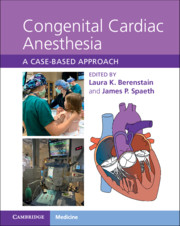Book contents
- Congenital Cardiac Anesthesia
- Congenital Cardiac Anesthesia
- Copyright page
- Dedication
- Contents
- Contributors
- Introduction
- Chapter 1 A Congenital Heart Disease Primer
- Section 1 Left-to-Right Shunts
- Section 2 Right-Sided Obstructive Lesions
- Chapter 6 Critical Pulmonic Stenosis
- Chapter 7 Tetralogy of Fallot
- Chapter 8 Repaired Tetralogy of Fallot
- Chapter 9 Tetralogy of Fallot with Absent Pulmonary Valve Syndrome
- Chapter 10 Tetralogy of Fallot, Pulmonary Atresia, and Aortopulmonary Collaterals
- Chapter 11 Pentalogy of Cantrell
- Chapter 12 Ebstein Anomaly
- Chapter 13 Ebstein Anomaly, Palliated
- Section 3 Left-Sided Obstructive Lesions
- Section 4 Complex Mixing Lesions
- Section 5 Single-Ventricle Physiology
- Section 6 Heart Failure, Mechanical Circulatory Support, and Transplantation
- Section 7 Miscellaneous Lesions and Syndromes
- Index
- References
Chapter 7 - Tetralogy of Fallot
from Section 2 - Right-Sided Obstructive Lesions
Published online by Cambridge University Press: 09 September 2021
- Congenital Cardiac Anesthesia
- Congenital Cardiac Anesthesia
- Copyright page
- Dedication
- Contents
- Contributors
- Introduction
- Chapter 1 A Congenital Heart Disease Primer
- Section 1 Left-to-Right Shunts
- Section 2 Right-Sided Obstructive Lesions
- Chapter 6 Critical Pulmonic Stenosis
- Chapter 7 Tetralogy of Fallot
- Chapter 8 Repaired Tetralogy of Fallot
- Chapter 9 Tetralogy of Fallot with Absent Pulmonary Valve Syndrome
- Chapter 10 Tetralogy of Fallot, Pulmonary Atresia, and Aortopulmonary Collaterals
- Chapter 11 Pentalogy of Cantrell
- Chapter 12 Ebstein Anomaly
- Chapter 13 Ebstein Anomaly, Palliated
- Section 3 Left-Sided Obstructive Lesions
- Section 4 Complex Mixing Lesions
- Section 5 Single-Ventricle Physiology
- Section 6 Heart Failure, Mechanical Circulatory Support, and Transplantation
- Section 7 Miscellaneous Lesions and Syndromes
- Index
- References
Summary
Tetralogy of Fallot (TOF) is the most common form of cyanotic heart disease and represents up to 10% of all congenital heart defects. The first complete repair was reported by Lillehei in 1954; in the current era most cases are repaired within the first 6 months of life. Although TOF is one of the most successfully repaired cardiac lesions, if left unrepaired mortality in the first several years of life can approach 50%. As with many congenital cardiac lesions, there is a spectrum disease severity in TOF. In patients with uncorrected TOF the anesthesiologist must be prepared to manage hypercyanotic spells and possible associated hemodynamic instability. This chapter details the perioperative assessment and management of an infant with uncorrected TOF with significant right ventricular outflow tract obstruction.
Keywords
- Type
- Chapter
- Information
- Congenital Cardiac AnesthesiaA Case-based Approach, pp. 39 - 44Publisher: Cambridge University PressPrint publication year: 2021

